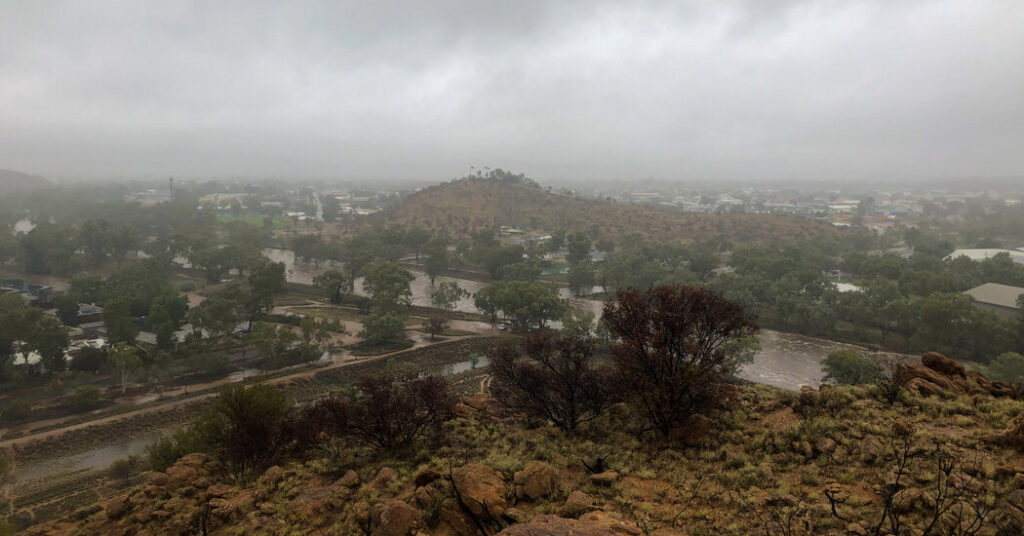The Australia Letter is a weekly e-newsletter from our Australia bureau. Sign up to get it by e mail.
Whenever there’s rain within the forecast for the desert city of Mparntwe, in any other case generally known as Alice Springs, the identical query normally surfaces: “Do you think the Todd will flow?”
This week, the reply was sure. The usually dry Todd River swelled with water on the again of every week’s price of rain that dropped 184 mm (about 7.2 inches) from the skies after months of unrelenting warmth, based on the Bureau of Meteorology. The rain picked up piles of particles, washed out roads and turned the normally pastel red-yellow panorama of the world in central Australia right into a wealthy tapestry of brown-green.
Local officers issued extreme flood warnings, however in a area normally outlined by arid warmth, folks have been excited — much more so when the water began to rise. People swarmed the Todd’s banks, reveling within the majestic sight of a river in movement.
It’s one thing folks on this a part of the world get to see only some instances a yr. Although the land is rarely utterly dry — a wealthy groundwater desk makes itself recognized by the rows of mature river purple gum bushes that line the banks — aboveground flows of any significance are contingent on massive rain.
John Wischusen, a hydrogeologist based mostly in Alice Springs, mentioned that the standard components for figuring out whether or not the Todd would circulate was 40 millimeters of rain at a price of fifty millimeters per hour. That’s a heavy downpour typical of a summer season thunderstorm, however he added that consecutive days of moist climate at a decrease depth additionally would (and this week, did) tip the scales.
“It’s like a roof and a water tank,” mentioned Mr. Wischusen, explaining how the excessive focus of Precambrian rocks (together with gneiss and granite) in and round Alice Springs inspired water runoff. “But the ground underneath has to be wet up to a certain level before it can flow past. That’s why you need a certain amount of rain and or intensity to get water to flow over the ground and into the river channels and through town.”
As it travels, the water recharges the panorama. Animals that beforehand stored a low profile abruptly present up. “You’ll hear all the frogs that have been dormant in the soil for a year come out and start chirping,” Mr. Wischusen mentioned. Valleys remodel into water holes, and groundwater storage methods replenish their shares.
The water corridors will not be what they as soon as the place — urbanization, invasive weeds and air pollution have reworked the panorama — but the river ecosystem is healed, nurtured and powered by these annual flows.
“Those big buildings built along the banks of the Todd are pretty hard on the eyes. But after a few flows, you notice they suddenly disappear, swallowed up by the growth of river red gums,” mentioned Peter Renehan, a Central Arrernte man who leads the Centre for Appropriate Technology, a science and know-how hub based mostly in Alice Springs. “For us, that’s country doing its work.”
For a few years, Mr. Renehan has spearheaded packages and dealing teams attempting to rejuvenate the broken riverbed. He identified trash (from small plastic wrappers to full-fledged mattresses) floating downstream due to unlawful campers, gutters that drain too shortly for the river to correctly soak up, and the plenty of invasive Buffel grass choking the corridors. Unlike native crops, these weeds encircle the bases of previous native river gums, thwarting their capability to function a frontline protection in opposition to lethal fires, and making it tougher for the water to maneuver because it ought to.
“We really want to be able to shine a light on the water systems within the town to actually show how beautiful it could be and how it used to be,” Mr. Renehan mentioned, including that the way in which the city breathes when the river runs is strictly why it warrants time, assets and sustained funding.
“All the negativity around the town just drops away as everyone comes together to view the river.”
There has been plenty of negativity for the city lately, a spot famous by nationwide media and politicians as a hotbed for youth crime. This week, the Northern Territory Chief Minister declared a state of emergency for Alice Springs, ordering a youth curfew and — together with different officers — calling on the federal authorities to ship the Australian Federal Police to assist guarantee security.
The political mayhem and discuss of a “town under siege” stood in stark distinction to the emotions stirred by the Todd.
Mr. Renehan was blunt: He mentioned the narrative wants to alter. He needs authorities to redirect the vitality it pours into legislation and order towards the safety, preservation and revitalization of the very factor that makes the city tick.
Aboriginal folks study by commentary — “feeling and seeing,” he mentioned — not by the federal government’s “slap in the face” strategy of extra massive buildings and supercharged constructed environments.
“We think we’re making progress, but then they go and do something like change the height restrictions,” he mentioned, including: “It’s a never-ending struggle to get them to understand the importance of the river.”
Now listed below are our tales of the week.
Enjoying the Australia Letter? Sign up right here or ahead to a good friend.


